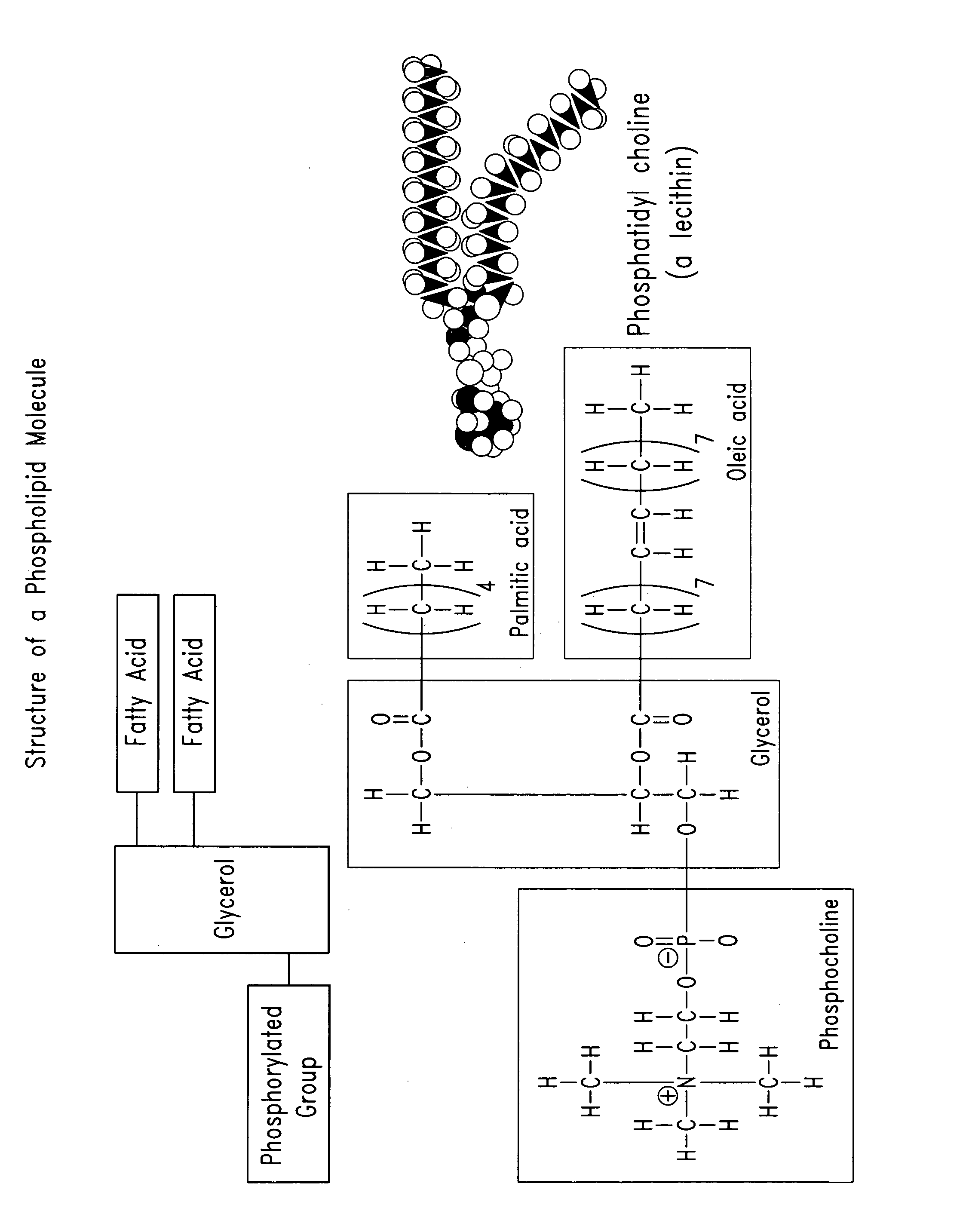Phospholipid compositions and methods for their preparation and use
a technology of phospholipids and compositions, applied in the field of biocompatible implant compositions, can solve the problems of limited safe sources of bovine collagen available for human use, relatively time-consuming and expensive preparation of collagen suitable for human use, and inability to completely remove contaminating and potentially immunogenic substances to produce collagen, etc., to achieve a wide range of consistency or firmness, reduce the cost of compositions, and little or no immune or inflammatory response
- Summary
- Abstract
- Description
- Claims
- Application Information
AI Technical Summary
Benefits of technology
Problems solved by technology
Method used
Image
Examples
example 1
Preparation of Phospholipid Pastes in Non-Aqueous Fluid Carriers and In Vivo Evaluation for Biocompatibility in Human
[0151] Two uniform lecithin gel / pastes were prepared to contain the following components:
% w / wComponentF-2F-3Soy lecithin (Phospholipon ® 90G)15.932.7Medium chain triglyceride (Miglyol ® 812)15.912.7Sucrose, NF15.912.7Ethanol, USP4.53.6Propylene glycol, USP47.838.3Total100100
[0152] Weigh out and combine soy lecithin (Phospholipon® 90G, an injectable grade soy lecithin containing about 90% phosphotidylcholine by Phospholipid GmbH), medium chain triglyceride (Miglyol® 812 by Sasol Corp.), sucrose, NF and propylene glycol, USP in a clean container, add anhydrous ethanol, USP to dissolve all solids to form a clear and yellow solution. Apply vacuum to remove ethanol until the residual ethanol content is less than 5% of the total weight. Warm up the mixture to 60° C. to form a transparent solution and then filter the solution through a sterilizing filter. Cool down the f...
example 2
Preparation of Phospholipid Pastes Imbedded with PMMA Microspheres in a Non-Aqueous Fluid Carrier and In Vivo Evaluation for Biocompatibility in Human
[0154] Uniform lecithin pastes was prepared to contain the following components:
% w / wComponentF-4F-5Hydrogenated soy lecithin (Phospholipon ® 90H)33.430PMMA microspheres20Propylene glycol, USP33.325Ethyl oleate, EP33.325Total100100
[0155] Weigh out and combine hydrogenated soy lecithin (Phospholipon® 90H, an injectable grade soy lecithin containing about 90% hydrogenated phosphotidylcholine by Phospholipid GmbH), propylene glycol (USP) and ethyl oleate (Crodamol EO by Croda) in a clean container, and heat the mixture to about 60° C. to obtain a transparent and slightly yellow solution. Filter the solution through a 0.2 micron sterilizing filter into sterile syringes. Place the syringes in an autoclave bag, and terminally sterilize the syringes and the contents therein using a 60-minute autoclave cycle (250° F.). Cool down the content...
example 3
Preparation of a Phospholipid Paste in an Aqueous Fluid Carrier
[0160] A uniform lecithin paste was prepared to contain the following components:
% w / wComponentF-6Hydrogenated soy lecithin (Phospholipon ® 90H)30Purified water70Total100
[0161] Weigh out and combine 15 parts by weight of hydrogenated soy lecithin (Phospholipon® 90H, an injectable grade soy lecithin containing about 90% hydrogenated phosphotidylcholine by Phospholipid GmbH) and 75 parts by weight of purified water in a clean container, heat the resulting mixture to about 60° C. and agitate it vigorously until a uniform paste is obtained. Apply vacuum to the paste to remove water until the water content is 70% w / w. Fill the paste into sterile syringes. Place the syringes in an autoclave bag, and terminally sterilize the syringes and their contents using a 60-minute autoclave cycle (250° F.). Cool down the contents in the syringes to room temperature to obtain a thick, opaque, off-while and uniform paste (F-6).
PUM
| Property | Measurement | Unit |
|---|---|---|
| Fraction | aaaaa | aaaaa |
| Fraction | aaaaa | aaaaa |
| Fraction | aaaaa | aaaaa |
Abstract
Description
Claims
Application Information
 Login to View More
Login to View More - R&D
- Intellectual Property
- Life Sciences
- Materials
- Tech Scout
- Unparalleled Data Quality
- Higher Quality Content
- 60% Fewer Hallucinations
Browse by: Latest US Patents, China's latest patents, Technical Efficacy Thesaurus, Application Domain, Technology Topic, Popular Technical Reports.
© 2025 PatSnap. All rights reserved.Legal|Privacy policy|Modern Slavery Act Transparency Statement|Sitemap|About US| Contact US: help@patsnap.com

